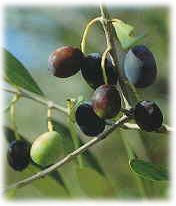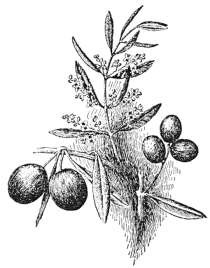Viña y Rosales Blog
name of author: Raúl
The olive (Olea europaea of the family Oleaceae) is native to coastal areas of the Western and eastern Mediterranean region, from Syria and the maritime parts of Asia Minor and northern Iran, at the south end of the Caspian Sea. The olive has a history almost as long as that of Western civilization, its development being one of civilized man's first accomplishments. At an archeological site in Spain, carbon-dating has shown olive seed found there to be eight thousand years old. Olive trees show a marked preference for calcareous soils, flourishing best on limestone slopes and crags with coastal climate conditions.The olive requires a long, hot growing season to properly ripen the fruit, no late spring frosts to kill the blossoms and sufficient winter chill to insure fruit set. The trees reach bearing age in about 4 years. Click on the linkage for a example of an Olive tree
The olive is an evergreen tree growing to 15 meter or 50 foot in height with a spread of about 9 meters or 30 foot. The tree can be kept to about 6 meter or 20 foot with regular pruning. The graceful, billowing appearance of the olive tree can be rather attractive. The gnarled branching pattern is also quite distinctive. Olives are long-lived with a life expectancy of 500 years and older. The trees are also tenacious, easily sprouting back even when chopped to the ground. The olive's feather-shaped leaves grow opposite one another. Their skin is rich in tannin, giving the mature leaf its gray-green appearance. The leaves are replaced every two or three years, leaf-fall usually occurring at the same time new growth appears in the spring.
The small, fragrant, cream-colored olive flowers are largely hidden by the evergreen leaves and grow on a long stem arising from the leaf axils. The olive produces two kinds of flowers. A perfect flower containing both male and female parts, and a staminate flower with stamens only. The flowers are largely wind pollinated with most olive varieties being self-pollinating, although fruit set is usually improved by cross pollination with other varieties. There are self-incompatible varieties that do not set fruit without other varieties nearby, and there are varieties that are incompatible with certain others. Incompatibility can also occur for environmental reasons such as high temperatures.
The olive fruit is a green drupe, becoming generally blackish-purple when fully ripe. A few varieties are green when ripe and some turn a shade of copper brown. The cultivars vary considerably in size, shape, oil-content and flavor. The shapes range from almost round to oval or elongated with pointed ends. Raw olives contain an alkaloid that makes them bitter and unpalatable. A few varieties are sweet enough to be eaten after sun drying. Thinning the crop will give larger fruit size. This should be done as soon as possible after fruit set.

Olives are now culivated in many regions of the world such as Australia, New Zealand, and California. There are thousands of cultivars of the Olive. In Italy alone at least three hundred cultivars have been enumerated, but only a few are grown to a large extent. The main Italian cultivars are 'Leccino', 'Frantoio' and 'Carolea'. None of these can be safely identified with ancient descriptions, though it is not unlikely that some of the narrow-leaved cultivars that are most esteemed may be descendants of the Licinian olive. The broad-leaved olive trees of Portugal and Spain bear a larger fruit, but the edible portion (the drupe) has a more bitter flavour and the oil is of poorer quality. These Iberian olives are usually cured and eaten, often after being pitted, stuffed (with pickled pimento, onion, or other garnishes) and jarred in fresh brine.
A fungus Cycloconium oleaginum can infect the trees for several successive seasons, causing great damage to plantations. A species of the bacterium Pseudomonas savastanoi induces tumour growth in the shoots. Certain lepidopterous caterpillars feed on the leaves and flowers while the main damage is created by olive-fly attacks on the fruit itself. In France and north-central Italy olives suffer occasionally from frost. Gales and long-continued rains during the gathering season also cause damage. On the whole the olive tree has hardly 'enemies'.
Most olives today are harvested by shaking the boughs or the whole tree. Lax practices such as using olives lying on the ground can result in poor quality oil. In southern Europe the olive harvest is in the winter months, continuing for several weeks but the harvest time varies in each country, and also with the season and the kinds cultivated. Like any fruit, all the olives on one tree will not be ready to harvest at the same time, so each tree will be revisited several times. Some olives are picked by hand, but most are harvested by shaking the tree, the olives drop into nets placed on the ground. They are taken straight to the local mill where, within the next 24 hours, they will be washed to remove leaves, twigs and earth. Then without delay they will be processed. The amount of oil contained in the fruit differs much between various sorts of olives. Olive fruits that are to be processed as green olives are picked while they are still green but have reached full size. They can also be picked for processing at any later stage up through full ripeness. Ripe olives bruise easily and should be handled with care. Mold is also a problem for the fruit between picking and curing.
There are several classical ways of curing olives. A common method is the lye-cure process in which green or near-ripe olives are soaked in a series of lye solutions for a period of time to remove the bitter principle and then transferred to water and finally a mild saline solution. Other processing methods include water curing and salt curing. Both green-cured and ripe-cured olives are popular as a relish or snack. The black colour is obtained by exposure to air after lye extraction and has nothing to do with ripeness.
Why use olive oil? It is necessary to include fat in a balanced diet as a source of energy, but which type of fat can have a direct bearing on health. For many years it has been well documented that in Mediterranean countries the number of people suffering from Coronary diseases is much lower than in other countries of Europe. This has been attributed to their diet. They tend to eat more fish, fresh fruit and vegetables and the main source of fat is olive oil rather than red meat. Olive oil is a mono-unsaturated fat which has been shown to provide protection against the build-up of cholesterol deposits while reducing deposits already there. Olive oil is a completely natural untreated food and this provides other benefits; it is rich in antioxidants and vitamins which help prevent body cell ageing. The oils can also be used on hands, hair and as a base for massage oil.
Which oil tastes the best? Similarly to wine this is a very personal thing, different oils suit different palates. There is far more diversity within olive oil than many people could ever imagine. Some oils are very fruity with undertones of melon, banana or lycee, this tends to apply to the Spanish oils. The Greek oils have deeper tones and of freshly cut grass. The best Italian oils tend to be very full bodied with a peppery finish. To find out which oils you prefer taste has many as you can and also remember that oils change their characteristics when heated. Again, similarly to wine, different oils are better suited to use with various foods. Olive oil is the only vegetable oil which is edible after pressing, without having to be treated in any other way. All other vegetable oils have to be treated to remove toxins. It takes 5 kilos of olives to produce 1 litre of oil, each tree produces on average 3 to 4 litres of oil.
The best quality oils have the lowest acidity levels;
Cold Pressed Extra Virgin Olive Oil - Acidity of less than 1%. Temperature during extraction below 30C.
Virgin (Select) Olive Oil - Acidity of less than 2%. Some heat is used during extraction.
Olive Oil - Acidity of less than 1.5%. A mixture of refined olive oil (obtained using heat) and virgin olive oil.
Pomace Olive Oil - Acidity of of less than 1.5%. A mixture of purified and refined oil with aprox. 10% virgin olive oil added to enhance taste and aroma.

Legends state that the immortality of the Greek gods came from their use of olive oil. Today, it's a way of life, it slows down the ageing process. Other legends tell other tales of the olive tree. Poseidon, God of the Sea, once fought for supremacy with Athene, Goddess of Wisdom and the Arts. He made salt water flow from the bare rock. She planted an olive tree and from the olives flowed a divine juice, olive oil. Olive oil might not confer immortality but it's healthy, beneficial and creates meals fit for the Gods. It is a blessing to mankind.
The plant and its products are frequently referred to in the Bible and by the ancient poets. The ancient agriculturists believed that the Olive would not succeed if planted more than a short distance from the sea; Theophrastus suggested 300 stadia (55 km or about 35 miles) as the limit. Modern experience does not always confirm this, although showing a preference for the coast, it has long since been grown further inland in some areas with suitable climates, particularly in the southwestern Mediterranean (Iberia) and northwest Africa, where winters are less severe. (Information derives from diverse sources)